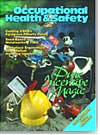
January 2004
Features
By Michael G. Dermer
WORK site safety and safety awareness are integral to success. When safety programs are made part of the broader organizational culture that rewards performance, successful safety programs do more than stem the financial and human resource loss.
By David S. Risi, CIH, CSP, CHMM
HUNDREDS of H&S software applications are available; choosing the one that can best address your needs can be a difficult process. During the past 17 years, I have seen a variety of procedures used to select software.
By Eileen Dedrick Torok, Peggy Carter-Ward
ARE you looking for a way to increase employee involvement in safety activities and training? Incentive programs can motivate employees to follow safety-related rules, complete required or recommended training, or participate in safety-related activities such as safety committees.
By Elizabeth Spevack
SAFETY is a key concern for many companies, and so many businesses make substantial investments in various forms of protective apparel and equipment for the eyes, head, hands, arms, and feet. This article will focus on the factors to consider when selecting hand protection for a particular task.
By Dennis R. Downing, Dr. J. Renae Norton
DO safety incentive programs work? This is a multimillion-dollar question when you consider the costs that unsafe practices can have for your organization. The simple answer is, it depends primarily on the focus of your safety program and secondarily on how well you implement your incentive program.
By Steven Zebich, S.E., P.E.
THIS is the time of year when we at Packer Engineering are often asked to investigate personal injury claims involving that old nemesis of the Great White North: "Unnatural Accumulation of Ice!" In the Midwest, we have to live with ice and snow as a regular part of our existence, and we know when traversing the slippery fields of frozen delights, one must traverse with a bit more care than in the middle of August.
By Frederick M. Spina, CSP, CPCU, REM
DURING the past 45 years, the metalworking production capacity of the United States has increased dramatically because of innovative changes in equipment technology. Machining, tools, and measuring instrumentation deliver lower tolerances that create finer lines of acceptance or rejection between profit and waste.
By Jerry Laws
THE Occupational Safety & Health Administration published its revised Log of Work-Related Injuries and Illnesses, Form 300, in October 2003. The most important change on the form and its companion summary, Form 300A, is the addition of a fourth specific illness column for hearing loss cases. The revision takes effect in January 2004.
By F. Gary Kovac
HAZARDOUS areas in manufacturing facilities require a device to protect workers from injury. A popular machine guarding solution is a safety mat system that, when stepped on, initiates a stop signal, preventing injury that may be caused by a piece of hazardous equipment.
By James Golden, CAE
SO many millions of personal computers have been sold over the past two decades, each with only one mouse, that most people think single-mouse operation is natural. Although it has become, by default, the norm, it is not necessarily natural.
By Matthew J. Gilligan, Charles H. Morgan
RECENTLY, the Occupational Safety and Health Review Commission handed down a decision that limits OSHA's use of its per-instance/per-employee "egregious penalty" policy. The decision in Secretary of Labor v. Erik K. Ho, Ho Express, Inc., and Houston Fruitland, Inc.,1 comes just months after OSHA announced its new "enhanced enforcement policy," which implements new tactics to crack down on the worst violators of the OSH Act.
By Chris Vanhoven
EACH year, injuries caused by manual materials handling are a significant cost to industry in terms of medical costs and lost productivity.
By John B. Vincent, Q.S.S.P.
DETERMINING which respirators best fit your emergency escape plans may be one of the most critical steps you can take to ensure employees have the best chance for escape from a terrorist situation, natural disaster, or industrial accident.
By Irving G. Jacob
VIOLENCE has emerged as an important safety and health issue in today's workplaces. Homicide, its most extreme form, is the second-leading cause of fatal occupational injuries in the United States. According to the Bureau of Labor Statistics' Census of Fatal Occupational Injuries, 709 workplace homicides occurred in 1998, accounting for 12 percent of the total 6,026 fatal work injuries in the United States.
By Robert Brown, CIH, CSP, CHMM
WHEN I first became an EHS manager, I thought I knew most of what I needed to know as a professional (during the years since then, I have found out just how much I didn't know), but I would, somewhat infrequently, seek help from an external consultant either to confirm my thoughts or to provide creative solutions for the "opportunities" I had identified.
Departments
By Louis Rovner, Ph.D.
THOUSANDS of terrorists call the United States home. It has been estimated that hundreds of terrorist sleeper cells are scattered throughout our country, waiting for orders and instructions.
By Valerie Weadock
IT'S a supercenter world. Stores that sell fishing tackle, car tires, lamps, and apples only aisles apart are thriving. These retailers may tout lower prices and friendly service, but if you ask customers why they shop at these locations, you'll hear one answer again and again--convenience.
By Jerry Laws
SUING someone seems like a sudden act, an angry impulse, but of course most lawsuits are the opposite. Case in point: the suit filed by the United Auto Workers and the United Steelworkers of America against Labor Secretary Elaine Chao and OSHA. Metalworking fluid exposures have concerned the UAW for many years.